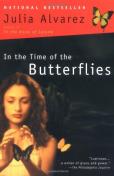BKMT READING GUIDES
In the Time of the Butterflies
by Julia Alvarez
Paperback : 325 pages
44 clubs reading this now
14 members have read this book
Introduction
(They were the four Mirabal sisters—symbols of defiant hope in a country shadowed by dictatorship and despair. They sacrificed their safe and comfortable lives in the name of freedom. Their codename in the revolution was Las Mariposas, "The Butterflies," and in this extraordinary novel, Patria, Minerva, Maria Teresa, and Dedé speak across the decades to tell their own stories. From tales of hair ribbons and secret crushes to gunrunning and prison torture, they describe the everyday horrors—and the unbelievable joy—of life in the Dominican Republic under the dictator Trujillo. Through the art and magic, the martyred Butterflies come to vibrant and dramatic life in a warm, brilliant, and heartbreaking story that makes a haunting statement about the human cost of political oppression.
Discussion Questions
1. Why is it so important for Minerva to go away to school with Patria? At school, what influence does her friend Sinita have on her? In what ways does Minerva, even at a young age, seem defiant and independent?2. How does Maria Teresa's diary help her throughout her life? In what ways do we see her grow up through her diary? Finally, in prison, how does the existence of a diary to write in save her?
3. How does the fight over Lio effect the relationship between Minerva and Dedé? Why does Dedé burn Lio's letter to Minerva? Is she really trying to protect her sister or is she just jealous?
4. What is the significance of the party at Trujillo's house that the Mirabal sisters attend with their father? In what ways will Minerva's actions haunt them?
5. How do the sisters react to the knowledge that their father has another family and that they have four little sisters? Why does Minerva want to help them? How do these illegitimate sisters help The Butterflies?
6. What does it mean to Dedé to be the only Mirabal sister left alive? Does she regret not joining the revolution? In the last sentence she says that she has been left alive to tell the story of her family. Does she appreciate the value of keeping the story alive?
7. Both in the story and in real life, the Dominican people stood behind the Mirabal sisters and saw them as great heroes and martyrs. Why is the Dominican nation so taken with the Mirabal sisters? What about them is so captivating? Of all those who fought for freedom from Trujillo, why does the story of these women endure?
Suggested by Members
Notes From the Author to the Bookclub
AN INTERVIEW WITH JULIA ALVAREZ What inspired you to write about the Mirabal sisters? They were—the three who died—the ones who stayed and sacrificed their lives and brought freedom to the Dominican Republic. We were the ones that got away, my father, my mother, my sisters and myself. My father was part of the same group as the Mirabal sisters and we got out and they didn't get out. There's always the responsibility of the survivors to tell the story of those who didn't make it. People ask how long it took to write this book and I say, "all my life." November 25th is the date in all our minds, those who survived. It is an important that for us and to everyone. The United Nations has even declared November 25th the International Day Against Violence Against Women because of the Mirabal sisters. How did you go about finding voices for the Mirabal sisters? What was the greatest challenge in bringing historical heroes alive in fiction? That's such a mysterious process involved with anything I write. I don't know if it's going to be a live one until I have the voice. The whole tone and movement and vocabulary is the most important thing. I struggled with finding each sister's individual characteristics and even in the case of Marie Teresa, the different ways they would structure their stories. That's a good mysterious unanswerable question. Sometimes you have the story and you don't have the voice. A novel is truth according to character, so if there's no voice, there's no story. The biggest challenge I find is the same with any character, however invented, is to saturate yourself, to become, in a way, that character. To saturate oneself in the creating of the character and putting them on paper. That's true of totally fictional or historical characters. You've got some of the facts, testimonies, points of view, and then you absorb all of this to turn it into something. Even if the character's a mandolin player and you absorb all that there is to know about mandolins, the challenge is to make that voice come alive on paper. With a historical character, it's just different kind of information that you have to give voice to, but it's still crystallizing all that material—whether it's a historical figure or details or story lines—and putting it together. What are you working on now? I just came back from a book tour with a new young adult title, Before We Were Free. The work was the second part of "book biz", as opposed to writing; the promoting and visiting bookstores and meeting readers, which is the best part. Basically introducing it to the world. Now, coming home, I'm working on a book of poems. And on finding an illustrator for a picture book for children, The Legend Of Altagratia, that's already written.Book Club Recommendations
Recommended to book clubs by 5 of 5 members.
Book Club HQ to over 88,000+ book clubs and ready to welcome yours.
Get free weekly updates on top club picks, book giveaways, author events and more








